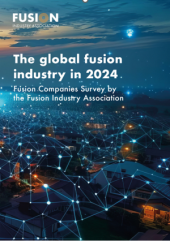
The fusion industry has now attracted over $7.1bn of investment, according to an annual report from the Fusion Industry Association (FIA), but major challenges remain. More than $900m of new funds are backing the technology since last year. As part of that, total public funding increased by 57% in the last 12 months to $426m, showing governments increasingly see public-private partnerships as key to commercialising fusion.
The Global Fusion Industry in 2024 report, FIA’s fourth annual report, surveyed 45 private fusion companies, up from 43 last year. There were three new entrants into this year’s survey, while one company withdrew its efforts. FIA said the survey “should be seen as a snapshot in time; a view of the industry when the survey was conducted in the second quarter of 2024”. Repeating the activity year-on-year enables us to see the picture evolving.
Total funding came from a wide range of investments across many of the 45 fusion companies, including notable deals such as $100m for Xcimer, $90m for SHINE, and $65m for Helion. The US remains global leader for commercial fusion with 25 companies in the survey, followed by the UK, Germany, Japan, and China, all with three. Switzerland is a new entrant into this year’s report, hosting two fusion companies, while Australia, Canada, France, Israel, New Zealand, and Sweden all have one.
This year has also seen a leap in job numbers, with over 4,000 people around the world now employed in private fusion companies, a 34% increase since 2023 (1,034 more employees), and up nearly 300% since 2021 (3,011 more employees). Nearly half of those employed are engineers (48%), a quarter are scientists (25%), and a quarter are in other roles (27%).
“This year’s continued growth in investment and employee numbers are exactly what we should be seeing in a maturing industry,” said FIA CEOAndrew Holland. “In the face of continued challenges in raising capital for ‘deep-tech’ ventures, the additional funding underscores confidence in fusion technology’s potential to revolutionize the global energy landscape on a timescale that is relevant to investors. Plus, with government policies shifting to direct more public funding into private fusion companies, the major players are aligning behind a shared goal.”
Notable public-private partnerships that have moved forward in the last year include the Milestone-based fusion development programme in the United States, the German government’s new “Fusion 2040” initiative; the Japanese government’s new “Fusion Moonshot” goal; and the UK Government’s new “Fusion Futures” programme.
Companies remain steadfast in their projected timelines for producing fusion-generated electricity in the 2030s, with 89% of the companies responding to the survey anticipating that fusion will provide electricity to the grid by the end of 2030s, and 70% of the companies saying that milestone will happen by the end of 2035. Since this report was first released in 2021, these questions have received similar answers. We have not seen timelines slip. “The industry is hitting its own milestones, and remains on track,” said Holland.
However, there are still major challenges to overcome and, between 2025 and 2030, two-thirds of respondents believe power efficiency will be a major challenge, while the same proportion (66%) believe funding will be a barrier to success. “Ambitious targets need ambitious resources and a step change in growth will be required once private companies deliver results on their prototype machines,” Holland noted. “The growth seen in the last 12 months is positive but will not be enough to deliver fusion’s ambitious goals. The sector needs continued support from public and private investors if it is to continue to innovate.






